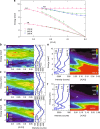Intrinsic anharmonic localization in thermoelectric PbSe
- PMID: 31028271
- PMCID: PMC6486597
- DOI: 10.1038/s41467-019-09921-4
Intrinsic anharmonic localization in thermoelectric PbSe
Abstract
Lead chalcogenides have exceptional thermoelectric properties and intriguing anharmonic lattice dynamics underlying their low thermal conductivities. An ideal material for thermoelectric efficiency is the phonon glass-electron crystal, which drives research on strategies to scatter or localize phonons while minimally disrupting electronic-transport. Anharmonicity can potentially do both, even in perfect crystals, and simulations suggest that PbSe is anharmonic enough to support intrinsic localized modes that halt transport. Here, we experimentally observe high-temperature localization in PbSe using neutron scattering but find that localization is not limited to isolated modes - zero group velocity develops for a significant section of the transverse optic phonon on heating above a transition in the anharmonic dynamics. Arrest of the optic phonon propagation coincides with unusual sharpening of the longitudinal acoustic mode due to a loss of phase space for scattering. Our study shows how nonlinear physics beyond conventional anharmonic perturbations can fundamentally alter vibrational transport properties.
Conflict of interest statement
The authors declare no competing interests.
Figures





References
-
- Zlatic, V. & Hewson, A. (eds.). New Materials for Thermoelectric Applications: Theory and Experiment (Springer, Berlin, 2013).
-
- Wood C. Materials for thermoelectric energy conversion. Rep. Prog. Phys. 1988;51:459. doi: 10.1088/0034-4885/51/4/001. - DOI
Publication types
Grants and funding
LinkOut - more resources
Full Text Sources

